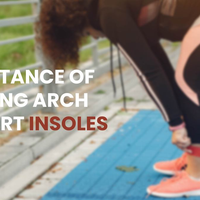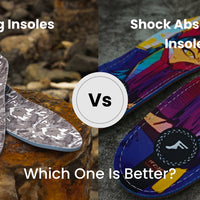Heated Insoles vs Heated Socks: Which One is Better?

When it comes to maintaining warmth in your feet during cold weather, heated socks and heated insoles are commonly favored choices. Both alternatives provide a remedy to combat the cold temperatures of winter and guarantee that your feet remain snug and content. This article will analyze heated socks and heated insoles to ascertain which option is more appropriate for your requirements.
Heated socks are typically battery-operated and come with heating elements that are strategically placed to cover the toes, soles, and even the sides of the feet. They can provide consistent warmth throughout the day, making them a popular choice for outdoor activities such as skiing, snowboarding, and hunting. Heated socks are usually made from a combination of materials that are moisture-wicking and breathable, ensuring that your feet remain dry and comfortable even when they are producing heat.
On the other hand, heated insoles are inserts that can be placed inside your regular shoes or boots. They are also powered by batteries and feature heating elements that offer targeted warmth to the soles of your feet. Heated insoles are a versatile option as they can be easily transferred from one pair of shoes to another, allowing you to enjoy warmth in a variety of footwear choices.
They are also lightweight and low-profile, making them a discreet option for everyday use.When comparing heated socks and heated insoles, it ultimately comes down to personal preference and individual needs. If you prefer the convenience of simply slipping on a pair of heated socks and having your whole foot covered with warmth, then heated socks might be the better option for you.
However, if you require targeted warmth and want the flexibility to use the heating element in different pairs of shoes, heated insoles might be the more suitable choice.
What are Heated Socks and Heated Insoles?
Definition of Heated Socks
Heated socks are specially designed socks that come with built-in heating elements. These elements are powered by rechargeable batteries and are strategically placed to provide warmth to your feet, particularly focusing on the toe area. Heated socks are great for anyone who struggles with cold feet, whether it be due to poor circulation, being in cold environments, or participating in winter sports or activities. They are often used by skiers, snowboarders, hunters, and outdoor enthusiasts who need to stay warm and comfortable in chilly conditions.
These socks typically have multiple heat settings, allowing you to adjust the level of warmth to your preference.
They are made from durable and moisture-wicking materials to keep your feet dry and comfortable. Some heated socks also come with remote controls or smartphone apps for easy temperature regulation.
In addition to providing warmth, heated socks can also help improve circulation in your feet, relieve pain and discomfort from conditions like Raynaud's disease or arthritis, and prevent frostbite in extreme cold conditions.
Overall, heated socks are a practical and effective solution for keeping your feet toasty warm in the coldest of temperatures. They are a great investment for anyone who needs extra warmth and comfort for their feet during the winter months.
Definition of Heated Insoles
Heated insoles, on the other hand, are heated inserts that can be placed inside your regular shoes or boots. Similar to heated socks, they also contain heating elements and a battery that heats up to keep your feet warm. Heated insoles are a great option for those who don't want to invest in heated socks or who prefer to use their own footwear. They are also more versatile as they can be easily transferred between different pairs of shoes or boots.
There are various types of heated insoles available on the market, with some being able to be controlled and adjusted through a mobile app or remote control. This allows for customizable heat settings to suit your comfort level.
Heated insoles are often rechargeable, either through a USB cable or a charging station, making them convenient to use on the go. They are also durable and long-lasting, providing hours of warmth during cold weather activities such as skiing, snowboarding, hiking, or simply walking in chilly conditions.
Overall, heated insoles are a great investment for anyone looking to keep their feet warm and comfortable in cold weather. They provide a convenient and effective way to combat the chill and ensure that your feet stay cozy and cozy all day long.
Key Differences between Heated Socks and Heated Insoles
The main difference between heated socks and heated insoles lies in their design and how they deliver warmth to your feet. While heated socks cover your entire foot, heated insoles provide heat from the bottom of your feet. This impacts the overall experience in terms of comfort and effectiveness. Heated socks typically have individual heating elements located in the toe and heel areas, which heat up the entire foot from top to bottom. This ensures that every part of your foot stays warm and toasty, making them a great option for people who suffer from cold feet or circulation issues.
On the other hand, heated insoles are designed to be inserted into your existing shoes or boots, providing heat from the bottom of your feet. While they may not cover your entire foot like heated socks, they are often more convenient and versatile as they can be easily transferred between different pairs of shoes.
In terms of comfort, heated socks may feel more natural and provide a more consistent level of warmth as they completely cover your foot. Heated insoles, on the other hand, may feel bulkier in your shoes and may not distribute heat as evenly across your foot.
Ultimately, the choice between heated socks and heated insoles will depend on your personal preference and needs. If you value overall foot coverage and comfort, heated socks may be the better option. If you prefer a more versatile and portable heating solution, heated insoles may be the way to go.
Which Provides Better Warmth: Heated Socks or Heated Insoles?
Comparison of Heating Mechanisms
Heated socks typically offer more direct warmth as the heating elements are in direct contact with your feet. On the other hand, heated insoles may distribute heat more evenly across the sole of your foot, providing a more balanced warmth experience. Additionally, heated insoles are generally more versatile as they can be easily transferred between different pairs of shoes, whereas heated socks may be more limiting in terms of the types of footwear that can be worn with them.
In terms of comfort, some people may find heated insoles more comfortable as they are often thinner and less bulky than heated socks. However, others may prefer the feeling of a sock over the insole.
Ultimately, the choice between heated socks and heated insoles comes down to personal preference and which option provides the most comfort and warmth for you. Both can be effective in keeping your feet warm in cold weather, so it may be worth trying both to see which you prefer.
Effectiveness in Extreme Cold Conditions
For extreme cold conditions, heated socks might have an edge over heated insoles due to their ability to cover your entire foot and provide all-round warmth. However, heated insoles are also effective in keeping your feet warm in chilly environments. Heated socks are typically battery-operated and have heating elements built into the fabric, providing warmth from the toes up to the ankles. This makes them ideal for outdoor activities in cold weather, such as skiing, snowboarding, or hunting.
On the other hand, heated insoles are inserted into your shoes and provide heat directly to the sole of your foot. They are more discreet and versatile, as they can be easily transferred from one pair of shoes to another. Heated insoles are also great for everyday use in cold weather, such as commuting to work or running errands.
Both heated socks and heated insoles can be adjusted to different heat levels, offering customizable warmth to suit your preferences. Ultimately, the decision between heated socks and heated insoles comes down to personal preference and the specific activities you will be engaging in.
Pros and Cons of Heated Socks vs Heated Insoles
Heated socks offer the convenience of being standalone, wearable items suitable for various footwear. On the other hand, heated insoles are versatile and can be switched between different pairs of shoes. Consider your specific needs and preferences when choosing between the two. Heated socks are designed to provide warmth and comfort to the entire foot, making them ideal for cold weather activities such as hiking, skiing, or snowboarding. They are often made with a thicker material to ensure proper insulation and can be easily adjusted for a customized fit. Heated socks typically come with a rechargeable battery pack that can provide hours of heat on a single charge.
Heated insoles, on the other hand, are designed to fit inside any pair of shoes or boots, making them a versatile option for everyday use. They are thinner and more discreet compared to heated socks, making them suitable for dress shoes or other footwear where heated socks may be too bulky. Heated insoles also come with a rechargeable battery pack that can be easily switched between different pairs of shoes, allowing you to have heated comfort in all of your footwear.
Ultimately, the choice between heated socks and heated insoles comes down to personal preference and intended use. If you primarily engage in outdoor activities in cold weather and want the added warmth and cushioning of heated socks, then heated socks may be the better option for you. However, if you want the flexibility of adding warmth to any pair of shoes and prefer a more discreet option, then heated insoles may be the better choice. Consider your specific needs and preferences to determine which option is best for you.
Are Heated Socks or Heated Insoles More Suitable for Skiing?
Advantages of Heated Socks for Skiing
Heated socks are a popular choice for skiing as they provide all-around warmth and comfort during cold weather activities. The heating elements in the socks can ensure your feet stay toasty while you hit the slopes. Heated socks work by using battery-powered heating elements woven into the fabric of the sock. These elements provide controlled heat to keep your feet warm, even in the coldest of temperatures. Most heated socks come with adjustable settings so you can customize the level of heat to your liking.
In addition to providing warmth, heated socks also often have moisture-wicking properties to keep your feet dry and comfortable throughout the day. This can help prevent blisters and other discomforts caused by dampness inside your boots.
For skiers, heated socks can be a game-changer, especially for those who struggle with cold feet or circulation issues. Having warm feet can make a big difference in your comfort and performance on the slopes, allowing you to stay out longer and enjoy your time on the mountain.
When choosing heated socks for skiing, look for ones that are durable, moisture-wicking, and have a good battery life. It's also important to make sure they fit well and won't cause any discomfort or restriction in your boots.
Overall, heated socks can be a great investment for skiers looking to stay warm and comfortable during their winter adventures. With the right pair, you can keep your feet happy and focus on having fun on the slopes.
Benefits of Using Heated Insoles in Ski Boots
Heated insoles are also suitable for skiing, especially when used with ski boots. The warmth they provide can enhance your skiing experience by preventing cold feet and keeping you focused on enjoying the slopes. Additionally, heated insoles can also help improve blood circulation in your feet, which can lead to better overall performance on the slopes. Cold feet can often lead to discomfort and fatigue, which can impact your ability to ski effectively.
Furthermore, heated insoles are adjustable, allowing you to choose your desired level of warmth based on the temperature and your personal comfort preferences. This can be particularly beneficial in colder conditions or for those with poor circulation.
Durability and Performance Comparison for Skiing
Both heated socks and heated insoles are durable and designed to withstand the rigors of skiing. Consider factors such as battery life, heating efficiency, and comfort when selecting the right option for your skiing adventures.
How to Care for Heated Socks and Heated Insoles?
Proper Washing and Maintenance of Heated Socks
When it comes to heated socks, it is essential to follow the manufacturer's instructions for washing and maintenance to ensure optimal performance and longevity of the heating elements. Typically, heated socks should be hand washed using a mild detergent and lukewarm water. Avoid using harsh chemicals or bleach, as this can damage the heating elements. After washing, gently squeeze out excess water and allow the socks to air dry completely before using them again.
It is also important to store heated socks properly when not in use. Make sure to unplug the battery and remove it from the socks before storing them in a cool, dry place. This will help prevent damage to the heating elements and extend the overall lifespan of the socks.
Regularly inspect the socks for any signs of wear and tear, such as frayed wires or damaged connectors. If any issues are found, it is best to have them repaired or replaced by the manufacturer to ensure continued safe use.
By following these guidelines for washing, maintenance, and storage, you can enjoy the warmth and comfort of your heated socks for many seasons to come.
Tips for Cleaning and Storing Heated Insoles
For heated insoles, regular cleaning and proper storage are key to maintaining their effectiveness. Avoid exposing the insoles to moisture or extreme temperatures when not in use. To clean your heated insoles, gently wipe them with a damp cloth or mild soap and water, making sure to dry them completely before using them again. Do not submerge the insoles in water or put them in the washing machine or dryer.
When storing your heated insoles, make sure they are completely dry and store them in a cool, dry place away from direct sunlight. Avoid storing them near heaters or other sources of heat, as this can damage the heating elements.
If your heated insoles become damaged or stop working properly, discontinue use immediately and contact the manufacturer for repairs or replacement. Do not attempt to repair the insoles yourself, as this can be dangerous and void any warranties.
By following these simple tips for cleaning and storing your heated insoles, you can prolong their lifespan and continue to enjoy the comfort and warmth they provide during cold weather.
Common Issues and Troubleshooting
Common issues with heated socks and insoles include battery life issues, heating element malfunctions, and connectivity problems. Refer to the product manual or contact customer support for troubleshooting assistance.
1. Clean the insoles regularly with a damp cloth and mild soap. Make sure to dry them completely before using them again to prevent mold or mildew buildup.
2. Do not submerge the insoles in water or put them in the washing machine. Instead, spot clean them as needed.
3. Allow the insoles to air dry completely before storing them. Do not use heat sources such as heaters or direct sunlight to dry them, as this can damage the heating elements.
4. Store the insoles in a cool, dry place when not in use. Avoid storing them in damp or humid environments, as this can affect their effectiveness.
5. Remove the insoles from your shoes when not in use for an extended period of time, such as during the off-season. Store them in a breathable bag or container to protect them from dust and dirt.
By following these simple tips, you can ensure that your heated insoles continue to provide warmth and comfort for years to come.
FAQs about Heated Socks and Heated Insoles
Can Heated Socks or Heated Insoles Overheat?
Both heated socks and heated insoles are designed with safety mechanisms to prevent overheating. However, it is essential to use them according to the manufacturer's instructions to avoid any risks of overheating.
Which is Better for Preventing Cold Feet: Heated Socks or Heated Insoles?
Both heated socks and heated insoles are effective in preventing cold feet, but your choice may depend on personal comfort preferences and the activities you engage in. Consider the pros and cons of each option before making a decision.
Are Heated Socks Versatile for Daily Wear Compared to Heated Insoles?
Heated socks are generally more versatile for daily wear as they can be easily paired with different types of footwear, providing warmth throughout the day. On the other hand, heated insoles may offer specific benefits for particular activities or shoe types.




